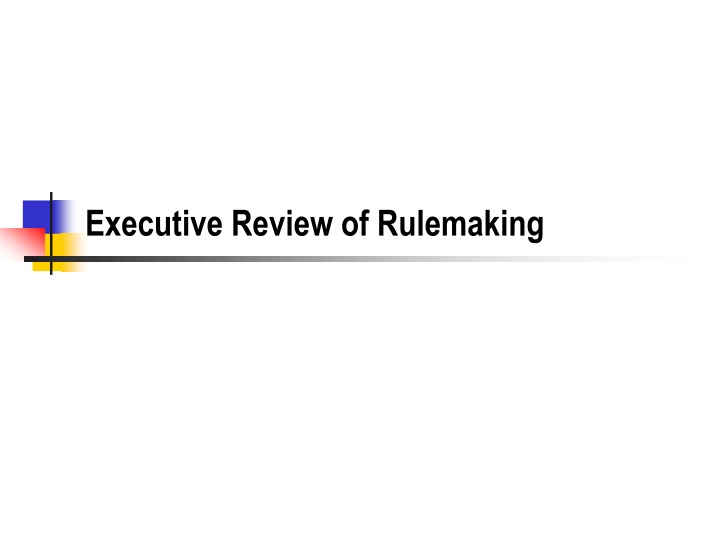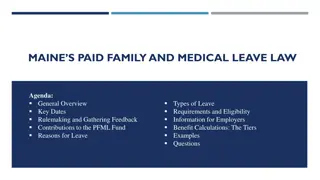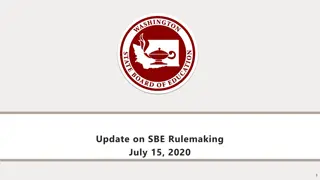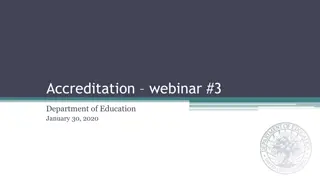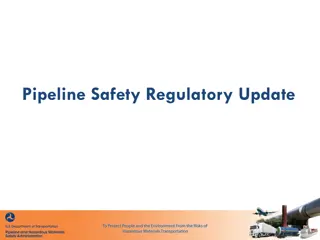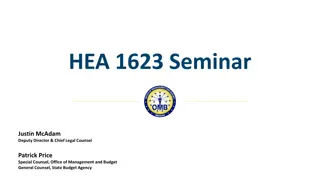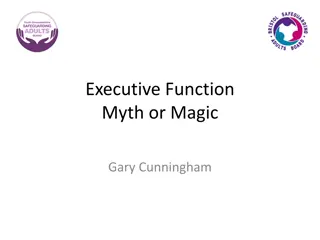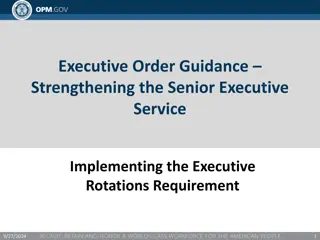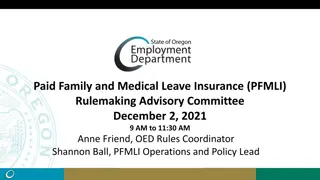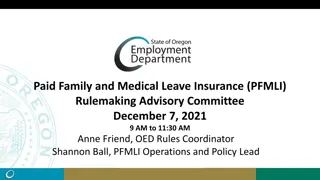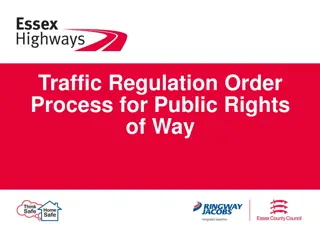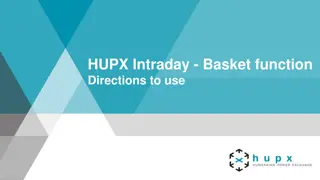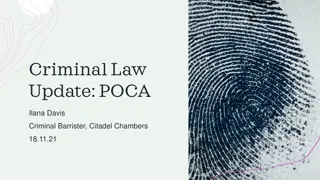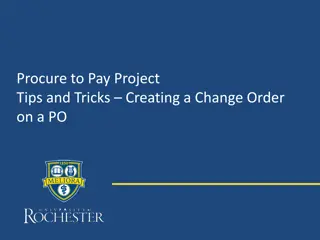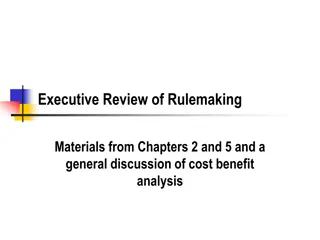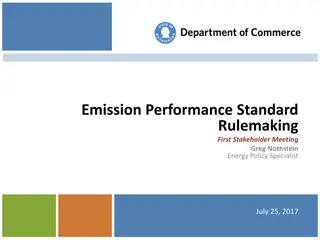Overview of Executive Orders on Rulemaking
This content provides an overview of the president's authority over rulemaking, including the coordination of agencies and ensuring alignment with the administration's objectives. It also introduces acronyms like OMB and OIRA. The content highlights various Executive Orders related to rulemaking, such as those addressing environmental justice, civil justice reform, and protection of children from health risks. The importance of consulting with Indian tribal governments and considering energy effects in regulations is also discussed.
Download Presentation

Please find below an Image/Link to download the presentation.
The content on the website is provided AS IS for your information and personal use only. It may not be sold, licensed, or shared on other websites without obtaining consent from the author.If you encounter any issues during the download, it is possible that the publisher has removed the file from their server.
You are allowed to download the files provided on this website for personal or commercial use, subject to the condition that they are used lawfully. All files are the property of their respective owners.
The content on the website is provided AS IS for your information and personal use only. It may not be sold, licensed, or shared on other websites without obtaining consent from the author.
E N D
Presentation Transcript
Executive Orders Regulating Rulemaking What is the president's authority over rulemaking? What about for independent agencies? Why should the president exercises authority over rulemaking? Coordination of agencies? Assuring that the agencies carry out the administration's objectives? 2
Acronyms OMB - Office of Management and Budget No content link as of 16 Feb 2017 OIRA - Office of Information and Regulatory Affairs 3
Executives Orders on Rulemaking E.O. 12630 Governmental Actions and Interference with Constitutionally Protected Property Rights Requires agencies when they issue rules with significant takings implications to discuss and identify the takings issues in their submissions to OMB. E.O. 12898 Federal Actions to Address Environmental Justice in Minority Populations and Low-Income Populations Requires agencies when practicable and appropriate to translate public documents relating to human health or the environment for limited- English-speaking populations. E.O. 12988 Civil Justice Reform Requires agencies to review any rules they issue to assure that they do not unduly burden the federal court system. 4
Executives Orders on Rulemaking E.O. 13045 Protection of Children from Environmental Health Risks and Safety Risks Requires agencies when they issue economically significant rules that concern health or safety risks that may disproportionately affect children to evaluate specifically the environmental or safety effects of the regulation and to explain why the planned rule is preferable to other alternatives. E.O. 13132 Federalism Requires agencies when they issue rules that impose substantial costs on state and local governments to consult with state and local officials early in the process and to publish in the preamble a description of the agency s consultation, the nature of their concerns, the need for the rule, and the extent to which the officials concerns have been met. 5
Executives Orders on Rulemaking E.O. 13175 Consultation and Coordination with Indian Tribal Governments Requires agencies to coordinate and consult with Indian tribes when they issue rules that have substantial direct effects on one or more Indian tribes, on the relationship between the Federal Government and Indian tribes, or on the distribution of power and responsibilities between the Federal Government and Indian tribes. E.O. 13211 Actions Concerning Regulations That Significantly Affect Energy Supply, Distribution, or Use Requires agencies to prepare a Statement of Energy Effects with regard to significant regulatory actions that are either likely to have a significant adverse effect on the supply, distribution, or use of energy or designated by the Administrator of the Office of Information and Regulatory Affairs as a significant energy action. E.O. 13272 Proper Consideration of Small Entities in Agency Rulemaking Requires agencies to provide draft rules to the Chief Counsel for Advocacy in the Small Business Administration and to give every appropriate consideration to the Chief Counsel s comments. 6
E.O. 13563Improving Regulation and Regulatory Review Elaborates five new principles to guide regulatory decisionmaking. First, agencies are directed to promote public participation, in part through making relevant documents available on regulations.gov to promote transparency and comment. It also directs agencies to engage the public, including affected stakeholders, before rulemaking is initiated. Second, agencies are directed to attempt to reduce redundant, inconsistent, or overlapping requirements, in part by working with one another to simplify and harmonize rules. Third, agencies are directed to identify and consider flexible approaches to regulatory problems, including warnings and disclosure requirements. Such approaches may reduce burdens and maintain flexibility and freedom of choice for the public. Fourth, agencies are directed to promote scientific integrity. Fifth, and finally, agencies are directed to produce plans to engage in retrospective analysis of existing significant regulations to determine whether they should be modified, streamlined, expanded, or repealed. 7
The Big One - Executive Order 12866 OIRA must review rules that have an impact of more than 100M aggregate or substantial impact on a segment of the economy or any thing else. 8
The Regulatory Philosophy Federal agencies should promulgate only such regulations as are required by law, are necessary to interpret the law, or are made necessary by compelling public need, such as material failures of private markets to protect or improve the health and safety of the public, the environment, or the well-being of the American people. In deciding whether and how to regulate, agencies should assess all costs and benefits of available regulatory alternatives, including the alternative of not regulating. 9
CBA under 12866 Costs and benefits shall be understood to include both quantifiable measures (to the fullest extent that these can be usefully estimated) and qualitative measures of costs and benefits that are difficult to quantify, but nevertheless essential to consider. 10
Choosing Among Alternatives Further, in choosing among alternative regulatory approaches, agencies should select those approaches that maximize net benefits (including potential economic, environmental, public health and safety, and other advantages; distributive impacts; and equity), unless a statute requires another regulatory approach. Pretty simple? :-) 11
What must the agency provide OIRA - I An assessment, including the underlying analysis, of benefits anticipated from the regulatory action (such as, but not limited to, the promotion of the efficient functioning of the economy and private markets, the enhancement of health and safety, the protection of the natural environment, and the elimination or reduction of discrimination or bias) together with, to the extent feasible, a quantification of those benefits; 12
What must the agency provide OIRA - II An assessment, including the underlying analysis, of costs anticipated from the regulatory action (such as, but not limited to, the direct cost both to the government in administering the regulation and to businesses and others in complying with the regulation, and any adverse effects on the efficient functioning of the economy, private markets (including productivity, employment, and competitiveness), health, safety, and the natural environment), together with, to the extent feasible, a quantification of those costs; 13
What must the agency provide OIRA - III An assessment, including the underlying analysis, of costs and benefits of potentially effective and reasonably feasible alternatives to the planned regulation, identified by the agencies or the public (including improving the current regulation and reasonably viable nonregulatory actions), and an explanation why the planned regulatory action is preferable to the identified potential alternatives. 14
12866 and Rulemaking Why is there a special provision for analyzing impact on small businesses? Does an executive order create private rights, i.e., can you challenge an agency's OIRA showing in court? 15
Where does the Court Stand on Requiring CBA? (Not in the book.) The enabling act is controlling In AFL-CIO v. API, 448 U.S. 607 (1980), the court found that OSHA enabling act required CBA on standards for benzene In American Textile Mfrs. Institute v. Donovan, 452 U.S. 490 (1981), the court found that OSHA did not have to do CBA because it was not required by the statute But can the agency do CBA anyway? How would you argue that it cannot? 16
How do these CBA and Review Requirements Affect Agencies? What are the effects on the agency? Fewer rules? Better documented rules? Less regulation? More danger to the public? Who benefits? Who loses? What is the financial impact? 17
Statutory Requirements National Environmental Policy Act (NEPA) imposes requirements if the rule affects the environment Regulatory Flexibility Act - small business Only direct effect on small business Rules on small truck standards might affect small business owners, but since it is directed at manufacturers, small business owners do not have standing Paperwork Reduction act - every rule that requires reporting must be reviewed CDC newsletter cannot ask for reader feedback Statutory requirements can create private rights 18
Information Quality Act Requires OMB to adopt guidelines ensuring and maximizing the quality, objectivity, utility, and integrity of information (including statistical information) disseminated by Federal agencies Why is this a redundant requirement? What could be the purpose of this requirement? 19
Unfunded Mandates Unfunded Mandates Act of 1995 - Agency must do a CBA if the costs exceed 100M What is an unfunded mandate? This will be a huge issue in the 2 for 1 EO. What would be the impact of banning unfunded mandates? What are the types and impact of unfunded mandates on public schools? 20
Congressional Review Act Most rules, including those exempt from notice and comment, must be reported to Congress, which has 60 days to review them There is a provision for emergency rules What can Congress do if it does not like the rule? When is this likely to happen? What about independent agencies? Why does this law not violate separation of powers? 21
